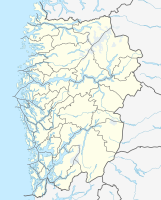Bergen harbor
| Bergen harbor | |||
|---|---|---|---|
| Data | |||
| Port type | seaport | ||
| Passengers | about 2 million | ||
| Goods handled | Bulk goods , containers etc. | ||
| website | www.bergenhavn.no | ||
| Geographic information | |||
| place | Mountains | ||
| province | Vestland | ||
| Country | Norway | ||
| The container port in Bergen | |||
| Coordinates | 60 ° 23 '54 " N , 5 ° 18' 53" E | ||
|
|||
The port of Bergen (Norwegian: Bergen Havn ) is the second largest seaport and the largest cruise port in Norway . In 2018 it handled 44 million tons and around 2 million passengers.
Bergen Havn AS , established in 2019, is a regional cooperation and belongs to the municipality of Bergen and the surrounding municipalities of Alver , Askøy , Austrheim , Bjørnafjorden , Fedje and Øygarden .
geography
The port of Bergen and the city center of Bergen are located along the Byfjord in the north and around the bay Vågen in the east, the Puddefjorden borders in the west, as well as the store Lungegårdsvann in the south, up to the mountain slopes of the surrounding seven mountains in the south Valley of Bergen ( Bergensdalen ). There are rocky heights around the port and the urban area of Bergen.
history
During the heyday of the Hanseatic League, the port of Bergen contributed significantly to the city's prosperity and was an important trading center in the northern European cities. The term “ mountain driver ” was even coined . From the Middle Ages to modern times, this was the name given to Hanseatic merchants and boatmen who were primarily active in the Norwegian trade with Bergen and the Bryggen office there (Tyskebryggen - the German bridge). This trading office was opened in 1360.
Until 1880, the port of Bergen was Norway's most important and Bergen was the country's largest city.
During the Second World War , Bergen was occupied by German troops on the first day of the German invasion on April 9, 1940 , who among other things expanded and fortified a submarine port .
charge
The port of Bergen has extensive tank capacities for oil as well as shipyards with dry docks. The cranes of the port facilities can lift up to 50 tons.
Ferry terminals
The port of Bergen is the starting point for the ferries on the Hurtigruten . The Skolten ferry terminal was renovated in the 2000s and now houses offices and warehouses. It is also used as a cruise terminal . In 2005, a modern terminal for coastal ferry traffic went into operation in Jekteviken .
See also
Web links
Individual evidence
- ↑ Om Bergen Havn , Bergen Havn, accessed June 9, 2020 (Norwegian)
- ↑ Cruise , Bergen Havn, accessed on June 9, 2020 (English)
- ↑ Information on the website of the Norwegian Statistical Office , accessed on August 24, 2019
- ↑ Facta om Bergen Havn , accessed on June 9, 2020 (Norwegian)
- ↑ Om Bergen Havn , accessed June 8, 2020 (Norwegian)
- ↑ Bergen og Omland Havnevesen: Scheduled routes, express boats, ferries, domestic and abroad ( page no longer available , search in web archives ) Info: The link was automatically marked as defective. Please check the link according to the instructions and then remove this notice. , accessed on October 14, 2012 (English)



